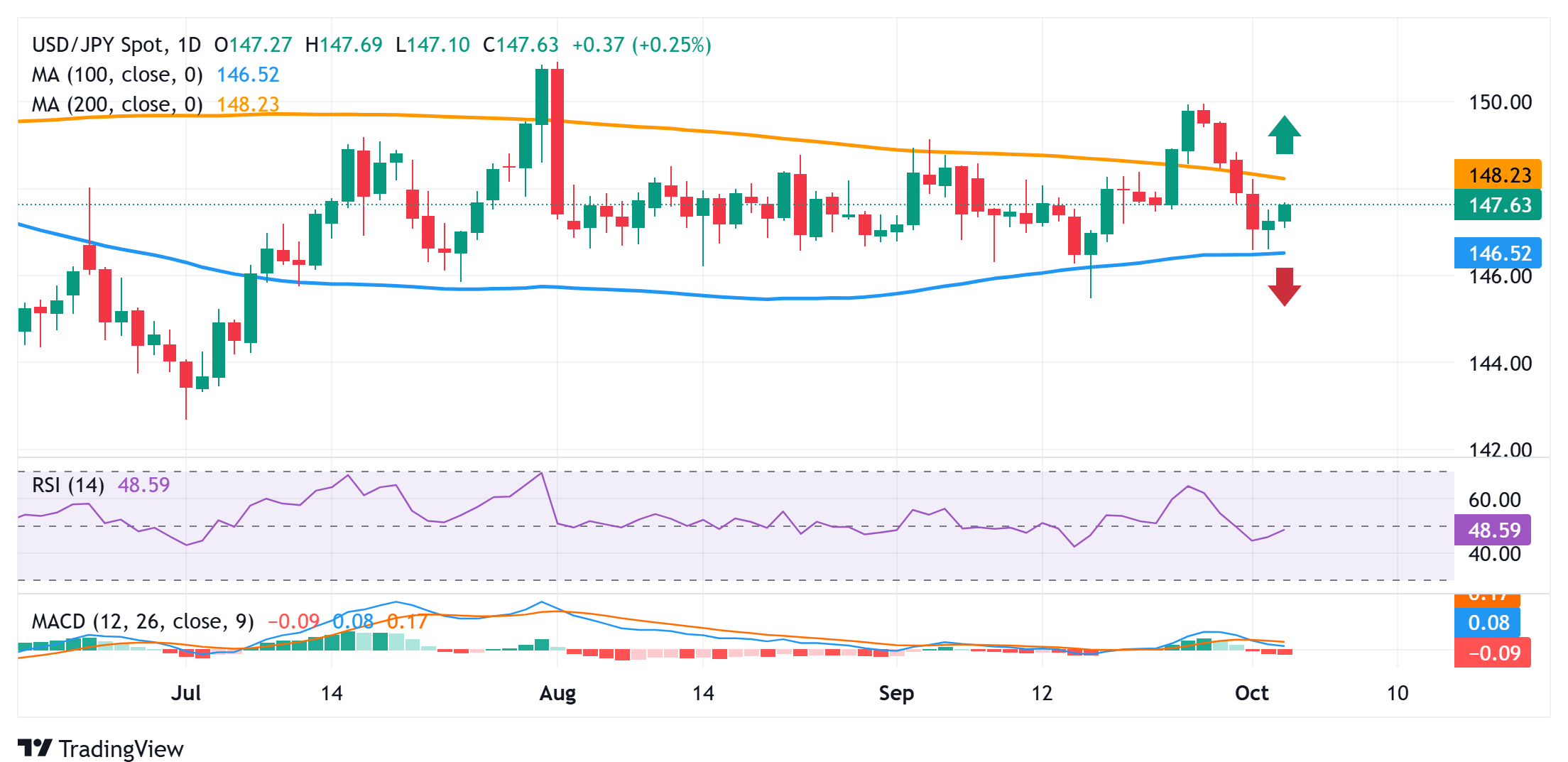Created
: 2025.10.03














![]() 2025.10.03 11:23
2025.10.03 11:23
The Japanese Yen (JPY) remains on the back foot against its American counterpart for the second straight day on Friday and moves away from an over two-week high touched the previous day. Data released earlier today showed that the Unemployment Rate in Japan rose more than expected, to 2.6% in August. Moreover, the upbeat market mood - despite the US government shutdown - turns out to be a key factor undermining the safe-haven JPY amid domestic political uncertainty. The US Dollar (USD), on the other hand, preserves Thursday's recovery gains from a one-week low and contributes to the USD/JPY pair's move beyond the mid-147.00s during the Asian session.
Any meaningful JPY depreciation, however, seems elusive in the wake of the growing acceptance that the Bank of Japan (BoJ) will stick to its policy normalization path and hike interest rates in October. This marks a significant divergence in comparison to bets that the US Federal Reserve (Fed) will lower borrowing costs two more times by the end of this year, which is seen acting as a headwind for the Greenback. Furthermore, the narrowing US-Japan rate differential supports the lower-yielding JPY and caps the USD/JPY pair. The US shutdown delayed the US Nonfarm Payrolls (NFP) report on Friday, leaving the USD and the pair at the mercy of speeches from influential FOMC members.

The USD/JPY pair has been showing resilience below the 147.00 mark and bounced off the 100-day Simple Moving Average (SMA) support near the 146.60-146.55 region for the second straight day on Thursday. The subsequent move up favors bullish traders. That said, oscillators on the daily chart have just started gaining negative traction, which, in turn, backs the case for the emergence of some selling near the 148.00 mark.
This is followed by a technically significant 200-day SMA, around the 148.35 zone, which, if cleared, might trigger a short-covering move. The USD/JPY pair might then climb to the 149.00 mark en route to the 149.35-149.40 region before making a fresh attempt to conquer the 150.00 psychological mark.
On the flip side, the 147.00 mark could protect the immediate downside ahead of the 146.60-146.55 pivotal support. Some follow-through selling has the potential to drag the USD/JPY pair to the 146.00 mark. The downward trajectory could extend further towards the September swing low, around the 145.50-145.45 region, en route to the 145.00 psychological mark.
The Japanese Yen (JPY) is one of the world's most traded currencies. Its value is broadly determined by the performance of the Japanese economy, but more specifically by the Bank of Japan's policy, the differential between Japanese and US bond yields, or risk sentiment among traders, among other factors.
One of the Bank of Japan's mandates is currency control, so its moves are key for the Yen. The BoJ has directly intervened in currency markets sometimes, generally to lower the value of the Yen, although it refrains from doing it often due to political concerns of its main trading partners. The BoJ ultra-loose monetary policy between 2013 and 2024 caused the Yen to depreciate against its main currency peers due to an increasing policy divergence between the Bank of Japan and other main central banks. More recently, the gradually unwinding of this ultra-loose policy has given some support to the Yen.
Over the last decade, the BoJ's stance of sticking to ultra-loose monetary policy has led to a widening policy divergence with other central banks, particularly with the US Federal Reserve. This supported a widening of the differential between the 10-year US and Japanese bonds, which favored the US Dollar against the Japanese Yen. The BoJ decision in 2024 to gradually abandon the ultra-loose policy, coupled with interest-rate cuts in other major central banks, is narrowing this differential.
The Japanese Yen is often seen as a safe-haven investment. This means that in times of market stress, investors are more likely to put their money in the Japanese currency due to its supposed reliability and stability. Turbulent times are likely to strengthen the Yen's value against other currencies seen as more risky to invest in.
![]()
Created
: 2025.10.03
![]()
Last updated
: 2025.10.03

FXStreet is a forex information website, delivering market analysis and news articles 24/7.
It features a number of articles contributed by well-known analysts, in addition to the ones by its editorial team.
Founded in 2000 by Francesc Riverola, a Spanish economist, it has grown to become a world-renowned information website.
We hope you find this article useful. Any comments or suggestions will be greatly appreciated.
We are also looking for writers with extensive experience in forex and crypto to join us.
please contact us at [email protected].
Disclaimer:
All information and content provided on this website is provided for informational purposes only and is not intended to solicit any investment. Although all efforts are made in order to ensure that the information is correct, no guarantee is provided for the accuracy of any content on this website. Any decision made shall be the responsibility of the investor and Myforex does not take any responsibility whatsoever regarding the use of any information provided herein.
The content provided on this website belongs to Myforex and, where stated, the relevant licensors. All rights are reserved by Myforex and the relevant licensors, and no content of this website, whether in full or in part, shall be copied or displayed elsewhere without the explicit written permission of the relevant copyright holder. If you wish to use any part of the content provided on this website, please ensure that you contact Myforex.
Myforex uses cookies to improve the convenience and functionality of this website. This website may include cookies not only by us but also by third parties (advertisers, log analysts, etc.) for the purpose of tracking the activities of users. Cookie policy